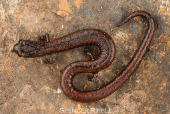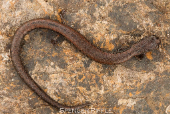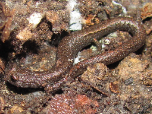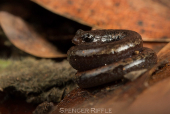San Simeon Slender Salamander (Batrachoseps incognitus)
Description: Adults are 1 1/2 to 1 9/10 inches long from snout to vent. A small thin salamander with 18 to 20 costal grooves.
Short limbs, a narrow head, long slender body, very long tail, and conspicuous costal and caudal grooves give this species the worm-like appearance typical of most Slender Salamanders. There are four toes on the front and hind feet, which is typical of all Slender Salamanders. (Other California salamanders have five toes on the hind feet.) Ground color is dark grey to brown or reddish brown. There may be a faint dorsal stripe. The venter is lighter in color than the dorsum and finely speckled.
Habitat: The salamander's natural habitats are riparian areas, chaparral and woodlands, and temperate coniferous forests in the Santa Lucia Range, from near sea level to 3,300 feet in elevation.
Range: The San Simeon slender salamander is endemic to California, in south-western Monterey and northern San Luis Obispo Counties in the western United States.
Found in these States:
CA
Diet: Probably eats a variety of small invertebrates. Feeding behavior is not known, but other Batrachoseps species are sit-and-wait predators that use a projectile tongue to catch prey.
Reproduction: Reproduction is terrestrial. Little is known about the breeding behavior of this species. Typically, Batrachoseps females lay eggs in moist places underground. Young develop completely in the egg and hatch fully formed.
Status: Listed as Endangered because its extent of occurrence (EOO) is 1,511 km2, it occurs in five or fewer threat-defined locations, and there is continuing decline in the extent and quality of its habitat.
»» Kingdom: Animalia - Animals
»» Phylum: Chordata - Chordates
»» Subphylum: Vertebrata - Vertebrates
»» Class: Amphibia - (Amphibians)
»» Order: Caudata - Salamanders
»» Family: Plethodontidae - Lungless Salamanders
»» Genus: Batrachoseps
»» Species: Batrachoseps incognitus - San Simeon Slender Salamander
This article uses material from the Wikipedia article "San Simeon Slender Salamander", which is released under the Creative Commons Attribution-Share-Alike License 3.0. Content may have been omitted from the original, but no content has been changed or extended.
|












